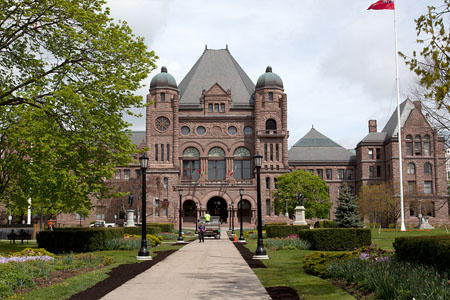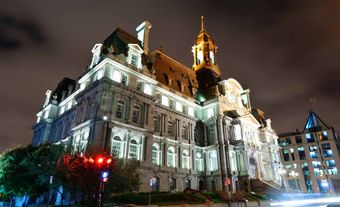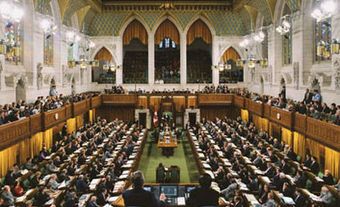Under Canada’s federal system, the powers of government are shared between the federal government and 10 provincial governments. The Constitution Act, 1867 granted specific jurisdiction to the provinces in 16 areas, compared to 29 for the federal government. However, provincial powers have expanded since then. Provinces can levy direct taxation and derive most of their non-tax revenue from the use of public lands and natural resources. Provincial governments in Canada are modelled on the British Westminster parliamentary tradition and reflect the principles of responsible government. They comprise an elected legislative assembly, from which a governing cabinet is selected by the premier. The lieutenant-governor assents to legislation as the representative of the Crown.

Rise of Provincial Power Since Confederation
Canada's original constitutional arrangements were far from those of a perfect or ideal federal state. The Fathers of Confederation sought to create a federal union with a strong central government. The federal government has the power to disallow provincial statutes within one year of their passage; to appoint provincial lieutenant-governors; to declare provincial works to be for the general advantage of Canada or two or more provinces; to appoint judges of superior, district and county courts; and to enjoy broad lawmaking authority. All of these powers confirm the junior status of provincial governments.
However, the evolution of Canadian society has eroded this early sense of provincial subordination. This has happened despite the swings towards greater centralization that occurred during the two world wars and the Great Depression. Not all provincial governments have been as assertive as those of Quebec or Alberta. But most claim a more equal partnership with Ottawa today than they enjoyed in the past.
The terms of Confederation gave the federal government the primary role in promoting an economic union and in stimulating national economic expansion. (See also Constitution of Canada; Quebec Resolutions; Distribution of Powers.) This was achieved through the development of transportation links (e.g., railways, harbours and canals, etc.) and other forms of public-policy support. (See also Railway History). By the 1880s, the momentum behind nation building had slowed. It was soon overtaken by the rise of provincially based political and economic needs and desires.
Historically, other key factors helped enhance the status of provincial governments. Provincial spokespersons — such as Ontario’s Oliver Mowat, Quebec’s Honoré Mercier and Nova Scotia’s William Fielding — exerted strong political leadership. Prime Minister Sir Wilfrid Laurier held a more sympathetic attitude towards the provinces than did Sir John A. Macdonald. Provinces gradually developed their resource-based economic interests. (See Resource Rights.) And perhaps most importantly, the Judicial Committee of the Privy Council (Canada’s highest court of appeal until 1949) delivered a string of rulings on the distribution of powers that favoured the provinces.
The provincial governments always played some role in their regional economic development. This happened through public investment in transportation and the growth of their public education systems. The expansion of these activities, along with the later growth of social assistance, health and hospital programs in the 1960s and 1970s, changed the initial conception of provincial government while also broadening its scope.
General and Specific Legislative Powers
The powers of the provincial legislatures were carefully limited by the Constitution Act, 1867 (section 92). The provinces were granted specific jurisdiction in 16 areas. In contrast, powers were granted to the federal Parliament in 29 areas (section 91).
The scope of provincial legislative power was broadly defined in the Constitution as “generally all matters of a merely local or private Nature in the Province.” Other more specific areas include:
- property and civil rights;
- the management and sale of provincially owned public lands;
- hospitals;
- municipal institutions;
- local works and undertakings;
- the incorporation of companies with provincial objectives;
- the formalization of marriage;
- and the administration of justice.
Provincial courts enforce both civil and criminal law. Under section 93, education is an exclusive provincial responsibility, subject to certain qualifications. Under section 95, agriculture and immigration overlap both jurisdictions but have federal paramountcy; if there is conflicting legislation, the federal statute prevails.
The control of public lands and provincial ownership of natural resources has proved to be of particular importance. However, the most relevant interpretations of the Constitution regarding provincial rights have concerned property rights and civil rights. These judicial rulings have guarded provincial jurisdiction against federal interests. They have also provided specific support for provincial regulation of labour relations, marketing, and business contracts.
|
Federal Jurisdiction |
Provincial Jurisdiction |
Shared Jurisdiction |
|
Public Debt & Property |
Direct Taxation within Province |
|
|
Regulation of Trade/Commerce |
Management/Sale of Public Lands within Province |
|
|
Direct/Indirect Taxation |
||
|
Formalization of Marriage |
||
|
Property & Civil Rights |
||
|
Navigation/Shipping |
Administration of Justice |
|
|
Tourism & Travel |
||
|
Sea Coast & Inland Fisheries |
Incorporation of Companies |
|
|
Ferries (interprovincial/intl.) |
|
|
|
Banking/Paper Money |
Local & Private Matters |
|
|
|
|
|
|
|
|
|
|
|
|
|
|
|
|
|
|
|
|
|
|
|
|
|
|
Marriage & Divorce |
|
|
|
|
|
|
|
Penitentiaries |
|
|
|
|
|
|
|
|
|
|
|
Railways |
|
|
|
|
|
|
|
|
|
|
|
|
|

Taxation and Other Revenue
Provincial taxing powers are limited to direct taxation within the province. This includes personal and corporate income taxes, consumer taxes and certain property taxes. The main source of provincial non-tax revenue is from the management, sale and leasing of public lands, timber and natural resources. A constitutional amendment in 1982 (92A) gave the provinces an unrestricted taxing power over natural resources. This amendment clarified and expanded provincial powers over non-renewable resources, forestry resources and electrical energy.
Disallowance and Reservation
The federal government has the power to disallow a provincial statute. It has not done so since 1943. Any federal Cabinet that thought of using disallowance today would face significant political hurdles.
Reservation is a lieutenant-governor’s power to hold off on assenting to a bill passed by the provincial legislature. She or he does so by deferring assent to the governor general. Rservations are also a relic of an earlier age. It is typically exercised only on instructions from the governor general. The last reservation in Canada — in Saskatchewan in 1961 — defied this convention; although the bill in question was subsequently approved.
Constitutional Change
There have been six constitutional amendments directly affecting the powers of the provinces. The amendments of 1940, 1951 and 1964 transferred powers to Parliament with the consent of the provinces; those of 1930, 1931 and 1982 expanded provincial powers. The 1940 amendment of section 91 (subsection 2A) gave the federal government jurisdiction over employment insurance. The numerous efforts at constitutional reform since the 1960s resulted in only one direct change in provincial jurisdiction: the 1982 section 92A natural resource taxation addition. (See also Constitutional History.)
Spending
Levels of government spending only partly reflect the range of provincial government activity; but they do underscore the role the provinces play in providing public goods and services, and in transferring payments to individuals. Total expenditures for all governments rose from 16 per cent of gross domestic product (GDP) in 1926 to 50 per cent in 2001. They then began falling, reaching 35 per cent in 2011. Almost none of the recent decline has occurred in the provinces; government spending there (excluding intergovernmental transfer payments) rose from three per cent in 1926 to 19 per cent in 2011. Government spending is of special significance to the economies of less prosperous provinces. (See also Public Finance; Intergovernmental Finance; Equalization Payments.)
Most provincial spending goes to hospital and medical care; education; income maintenance; and other social services. All provincial governments take part in federal-provincial, shared-cost arrangements for hospital insurance and medicare. This helps to ensure nationwide standards of service. (See Health Policy) It occurs despite differences between the provinces in their financing and program coverage. In contrast, the high degree of provincial autonomy in elementary and secondary education, and the accommodation of religious and linguistic minorities, has led to a variety of school systems across the country.
Revenue
Personal income taxes, general sales taxes and natural-resource revenues are the largest sources of provincial government revenue. The relative importance of each source varies by province. This is due to the wide variations in the provinces’ economies and taxation policies. Ontario and the four Atlantic provinces have harmonized their value-added sales taxes (Harmonized Sales Tax, HST) with the federal goods and services tax (GST). Alberta continues to be the only province not to levy a provincial retail sales tax.
Since 1962, the levying of income tax by both the federal and provincial governments has been governed by a series of five-year fiscal and tax-collection arrangements. The federal government collects personal income taxes for nine provinces (excluding Quebec); it collects corporation income taxes for eight provinces (all but Alberta and Quebec).

Federal Funding of Provincial Programs
The growth of the provinces’ activities has typically been due to their own programs (e.g., the introduction of public hospital insurance and medicare in Saskatchewan); or the fuller use of their taxation powers. But the federal government has also encouraged provincial growth. Federal shared-cost programs in areas of provincial jurisdiction contributed to the expansion and maintenance of provincial public services. Unconditional grants in the form of equalization payments have also played an important role.
Since 1977, however, the terms of federal financing arrangements have led to greater degrees of provincial autonomy. Federal budgetary restraints also imposed ever increasing limits on federal support for social assistance, hospitals, medicare and post-secondary education.
Change in Policy Agendas
The 1960s and 1970s were an expansionist, province-building era. In contrast, recent decades have seen major restructurings in the delivery of provincial education, health, and other social programs. This was driven in part by the three post-1985 economic downturns. Neo-conservative and smaller government approaches to public management were also a factor. The policy goals of budgets — balancing sustainability, economic development and trade promotion — have come to dominate all provincial government policy agendas.
Provincial Agencies
Various provincial government agencies and Crown Corporations conduct regulatory activity and programs for economic development. These initiatives play an important role in provincial life. Things that are regulated by provincial agencies include Workers' compensation; labour relations; agricultural marketing; liquor sales; energy; and public utilities.
Publicly owned development corporations and other provincial agencies provide assistance, loans and other incentives. This helps to expand and diversify provincial economies. These agencies often compete with one another, with varying degrees of success. Other provincial crown corporations are also important in provincial economies. This is especially true in the generation of electrical power. However, provincial government services and activities have contracted since the late 1990s. This has led to a re-examination of the role of some provincial crown corporations and agencies. In some cases, the option of privatization has been raised.
Government Institutions
Distinctive economic and social developments in the provinces have produced a variety of political cultures and party systems. However, all provincial governments are closely modelled on the British Westminster parliamentary tradition. Their practice of cabinet government reflects the principles of responsible government. The Crown is represented through the office of the lieutenant-governor. Public policymaking and administration are controlled by an executive council or Cabinet; it comprises elected ministers of the Crown and is headed by a premier. For lawmaking purposes, each provincial legislature is composed of the lieutenant-governor and the provincial legislative assembly. This is similar to the composition of the central Parliament, with the Governor General, Senate and House of Commons.
Four provinces originally had a bicameral (two chamber) legislature made up of an elected assembly and an appointed legislative council: Quebec (1867–1968); New Brunswick (1867–92); Nova Scotia (1867–1928); and Manitoba (1870–76). Prince Edward Island also had a bicameral Legislature but with an elected Council; it was absorbed into the lower chamber in 1893. Today, all have a unicameral system composed of a single elected chamber; it varies in size from 27 members in PEI to 125 in Quebec.
The political party that holds the majority of seats in the legislative assembly appoints members to cabinet. The premier and cabinet must maintain the support of the majority in the legislature. This is a principle of responsible government that was formally acknowledged in 1848 by the then colonies of the four original provinces.
Lieutenant-Governor
Since Canada is a constitutional monarchy, provincial government is carried out in the name of the Crown. The lieutenant-governor of the province acts as the Crown’s representative in all areas of provincial jurisdiction. They also exercise any related prerogative powers. The lieutenant-governors appoint and may dismiss the provincial premiers and the members of their cabinets. They summon, prorogue and dissolve the provincial legislatures. (See Parliamentary Procedure.) They assent to provincial legislation in the name of the Crown. The lieutenant-governors still retain a power to withhold or reserve a bill for consideration of the central government. (The latter power is presumed dormant, if not entirely inoperative.)
In practice, the lieutenant-governor’s constitutional responsibilities are limited by the conventions of responsible government; they are also conducted on the advice of the premier. The lieutenant-governor has the discretionary power to act alone in appointing or dismissing a premier or dissolving the legislative assembly; this can happen if there is uncertainty about who commands the support of the majority in the assembly. If a premier or cabinet acted in a way that clearly went against constitutional conventions, the lieutenant-governor could act to protect those fundamental principles.
The lieutenant-governors are appointed by the federal cabinet on the advice of the prime minister. Provincial governments are not involved in the selection process. Before 1892, lieutenant-governors were regarded as federal officers. Their salaries are fixed and are paid by Parliament. The Judicial Committee of the Privy Council held the appointment to be an act of the Crown. This ended any suggestion of subordinate status for lieutenant-governors — and by extension for the provincial legislatures. The Judicial Committee said the lieutenant-governor was as much the representative of the Crown in the provincial government as the governor general was for Canada.

Premier and Cabinet
Provincial premiers ordinarily hold the position of President of the Executive Council. They enjoy the same status as head of their governments as prime ministers hold in relation to the members of their federal cabinet.
Virtually all provincial cabinets are divided into ministries. They cover policy areas such as health; education; advanced education; jobs and skills training; labour; social services; energy; environment; natural resources (forests, lands or mines); economic development; agriculture; highways and transportation; tourism and recreation; justice; intergovernmental relations; finance; municipal affairs; and housing. Other ministries reflect the policy priorities of a particular province. For example, the Atlantic provinces and Quebec have specific fisheries portfolios.
In 2014, the average size of the provincial cabinets was 18 members. Ontario and Quebec were the largest with 27; PEI was the smallest with 11.
Legislative Process
The provincial legislative assembly is an important expression of Canadian democracy. (In Nova Scotia and Newfoundland and Labrador, it is known as the House of Assembly; in Quebec, it is called the National Assembly.) The process of making provincial law is similar to that of other parliaments. The government’s legislative proposals (bills) move through first reading, second reading and detailed review in committee stage. There is then a final third reading before the lieutenant-governor assents. The budgetary process also requires that the legislature annually approve the funds required for government programs. Expenditures are only made for purposes that are authorized by the legislative assembly.
In practice, there is rarely room for independent action by the legislature in the lawmaking process. The party loyalty of individual members of the assembly; the power of the party leadership to maintain discipline; and the government's control of the timetable of the assembly ensure that the work of the legislative assembly is dominated by the premier and cabinet. The modern emphasis on executive government has greatly enhanced the lawmaking powers of the cabinet and its ministers. The weight of government business undermines the backbencher's right to sponsor private members' bills; few such bills advance to become law. The general rule is that only the government may initiate spending and taxing proposals; this inevitably curtails backbench initiatives.
Electoral Trends and Policies
One-party dominance of the provincial assemblies has been a common occurrence in Canada. The Alberta Conservative Party (1971–2015); the Nova Scotia Liberal party (1882–1925); and the Ontario Conservatives (1943–85) enjoyed the longest periods of uninterrupted government office. The provinces’ first-past-the-post electoral systems also exaggerate government party majorities. An extreme example of this occurred in 1987; Frank McKenna’s Liberals captured 100 per cent of the 58 seats in the New Brunswick legislature with only 60.4 per cent of the vote. Minority governments at the provincial level have become more common since the 1980s.
Electoral reform through the adoption of a proportional representation system was the subject of provincial referenda in Prince Edward Island (2005); Ontario (2007); and twice in British Columbia (2005 and 2009). All fell short of the required voter support. British Columbia remains the only province to have provisions for citizens’ initiatives in lawmaking, and for the recall of its elected representatives.
See also Federal-Provincial Relations; Municipal Government in Canada; Municipal-Provincial Relations; Local Government; Territorial Government in Canada; Federalism in Canada; Decentralization.

 Share on Facebook
Share on Facebook Share on X
Share on X Share by Email
Share by Email Share on Google Classroom
Share on Google Classroom




